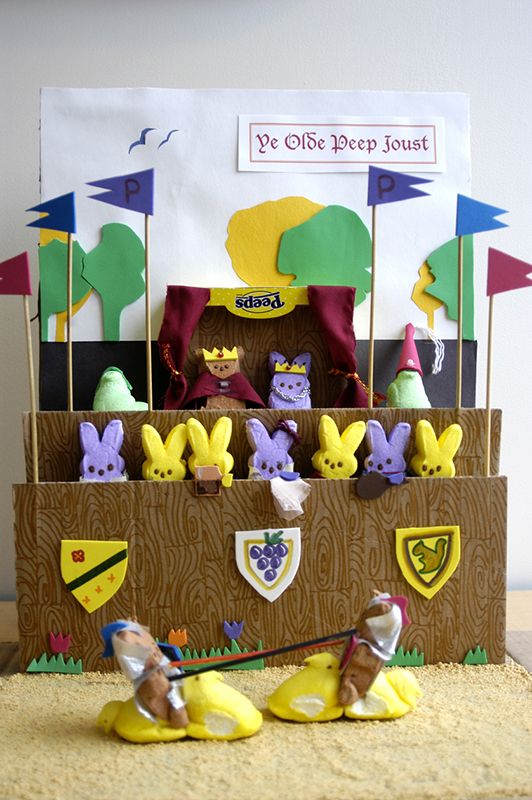A Peep Experiment
In peep jousting, two peeps, armed with toothpicks, battle it out in a microwave
This year, several of us at the magazine (including my colleague Amanda from Food and Think) got together to create an entry for this year’s Peeps Diorama contest from the Washington Post. Our entry, “Ye Olde Peep Joust,” was inspired by a more modern form of Peep jousting that involves two Peeps, armed with toothpicks, battling it out in a microwave.
When we finished our diorama and I looked at our leftover supplies, which included several open and unopened boxes of Peeps, I realized that I had the makings of a perfect Peep jousting experiment, one that would answer the question: Are fresh or stale Peeps better jousters?

Peep jousting rules, according to the Urban Dictionary, are as follows:
Each Peep has a toothpick sticking out of the front of it, like a lance. Two Peeps, so armed, are placed in a microwave facing each other. As they are heated, they expand, until one Peep's toothpick makes contact with the other.
Under these rules, the first Peep to pop is the loser. I hypothesized that given a joust between a fresh and a stale Peep, the stale Peep would not expand, or at least not expand as fast as the fresh Peep, and the fresh Peep would be the winner.
Methods
Two packages of Peeps brand marshmallow chicks were obtained from local vendors. The green Peeps were left exposed to the air and stored in the same drawer as the yellow unopened Peeps for approximately two weeks.
Peeps were separated using a standard razor blade. Each Peep was armed with a plain wooden toothpick, which was inserted at an approximately 45 to 50 degree angle in the belly of the Peep with 47 mm of toothpick exposed. The Peeps were then placed on paper plates, available in the Smithsonian Enterprises kitchen, facing each other and about 35 mm apart. The plate was placed in the middle of a GE Spacemaker II Sensor microwave in the SE kitchen. The microwave was set to run at full power for two minutes and was shut off when one Peep’s toothpick touched the losing Peep. If it appeared there would be no winner to a joust, the experiment was terminated when the scent of burning Peep was detected.
The experiment was run five times, and the results were recorded and tabulated.
Results
Round 1 was terminated after 24 seconds. The fresh Peep quickly expanded and knocked the jousting lance into a position where it was unlikely to hit the stale Peep. The stale Peep did not change in size or appearance. There was no declared winner.
Round 2 was terminated after 33 seconds when the fresh Peep's toothpick touched the stale Peep.
Round 3 was terminated after 24 seconds when the fresh Peep "self destructed" as an onlooker termed its explosion. There was no change to the stale Peep.
Round 4 was terminated after 35 seconds. The fresh Peep became huge in size but its toothpick did not touch the stale Peep. The stale Peep underwent a small amount of puffage.
Round 5 was terminated after 26 seconds when the fresh Peep's toothpick touched the stale Peep.
Discussion
Only two of the five runs had a winner as determined by the Urban Dictionary definition. However, it was clear that fresh Peeps more quickly puffed in the microwave tests and made better jousters than stale Peeps.
Three of the five runs did not have any winner because the toothpick of the fresh Peep was knocked well out of jousting position when the Peep began to puff. It is uncertain whether this was a result of faulty placement of the jousting lance; this is an area for additional study.
A secondary experiment (data not included here) in which the five stale Peeps were all run in the microwave together showed that they will puff, and thus can joust, but the time required is upwards of twice the length of jousting with fresh Peeps.
In conclusion, it is possible to joust with both fresh and stale Peeps. However, when jousting stale Peeps against fresh, the fresh Peeps make for better jousters.
/https://tf-cmsv2-smithsonianmag-media.s3.amazonaws.com/accounts/headshot/Sarah-Zielinski-240.jpg)
/https://tf-cmsv2-smithsonianmag-media.s3.amazonaws.com/accounts/headshot/Sarah-Zielinski-240.jpg)